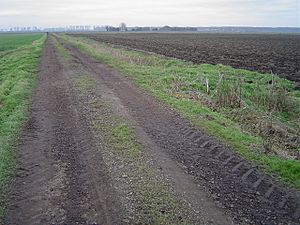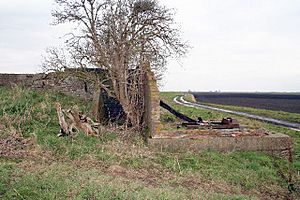Whittlesey Mere facts for kids
Whittlesea Mere was once a large area of open water, like a big lake, in a flat, marshy region of England called the Fenland. This area is now part of Cambridgeshire. The mere was located near the towns of Yaxley, Farcet, and Holme Fen. The town of Whittlesey was to its northeast.
Whittlesea Mere was the very last of the "great meres" (large shallow lakes) in the Fens to be drained. The old River Nene used to flow right through it. In summer, the mere covered about 1,870 acres (756 hectares). In winter, when there was more rain, it could grow to 3,000 acres (1,214 hectares). Local people used the mere for fishing, hunting wild birds, and gathering reeds and sedges. Rich families even enjoyed "water picnics" there!
Contents
A Visitor's View
In 1697, a traveler named Celia Fiennes saw the mere. She wrote that it was "3 miles wide and 6 miles long." She also mentioned a small island in the middle where many wild birds nested. Celia described the land around it as "wet and marshy." She warned that the mere could be dangerous because "sudden winds" could rise "like Hurricanes."
How Whittlesea Mere Changed
Before people started draining the Fens, this area had many shallow lakes. Whittlesea Mere was the biggest of them all. The River Nene originally flowed through this mere. Then it went south to another mere called Ugg Mere, before turning east towards the River Ouse.
By 1851, the mere had become much smaller. Dirt and peat (a type of soil made from decayed plants) had built up. This made the mere only about 400 hectares in size and just one meter deep.
Draining the Mere
A new main drain was built for the Middle Level Navigations in 1848. This new drain made it possible to finally drain Whittlesea Mere. Instead of using old-fashioned scoop wheels, a new type of pump was used. This was a centrifugal pump designed by John Appold.
The Amazing Pump
The Appold pump was first shown at the Great Exhibition in 1851. It was a very new invention at the time. The pump was 4.5 feet (1.4 meters) wide. A 25-horsepower (19 kW) steam engine powered it. This powerful pump could lift 101 tons of water every minute! It could raise the water by 2 or 3 feet (0.6 to 0.9 meters).
Who Paid for It?
A group of wealthy gentlemen and landowners paid for this huge project. They included William Wells, Heathcote of Conington Castle, Edward Fellowes of Ramsey Abbey, Thornhill of Diddington, Lord Sandwich, and Wentworth Fitzwilliam.
Draining the mere turned both the mere itself and Holme Fen into useful farmland. However, a problem called subsidence happened afterward. This means the ground started to sink because the water that supported the peat was removed.
What Was Found?
When the mere was drained, some amazing silver items were found in its bed. These included a thurible (a container for burning incense) and an incense boat. People believed they came from Ramsey Abbey because of a ram's head design on one piece. These items, along with a sword, are now kept in the Victoria & Albert Museum in London. Blocks of stone were also found. People think these stones might have fallen from a boat on their way to the Abbey.
Floods and Farming
In 1852, the mere filled with water again because of a flood. But it was drained once more. In 1862, a sluice (a gate that controls water flow) broke, and water flooded in again. Once more, the mere was drained, and farming continued.
Whittlesea Mere Today
The name 'Whittlesea Mere' still appears on maps today. However, you won't find a big lake there. The only water you'll see is in farmers' irrigation reservoirs and the ditches that drain the rich farmland.
The Future of the Mere
There's a big plan called the Great Fen Project. One day, this project might bring the mere back. Stage 3 of the project aims to return this area to a wetland, much like it was before it was drained.
Fun Local Stories
There's a local story about a boy from Holme. In February 1851, he was working to scare birds away from crops on Holme Fen. He wandered off and got stuck deep in the muddy reed beds of Whittlesey Mere, up to his armpits! He was hidden from view and stuck for 19 hours. He knew how long it had been by listening to the bells of All Saints Church, Conington. Luckily, another villager found him by chance, pulled him out, and took him home to his parents.



